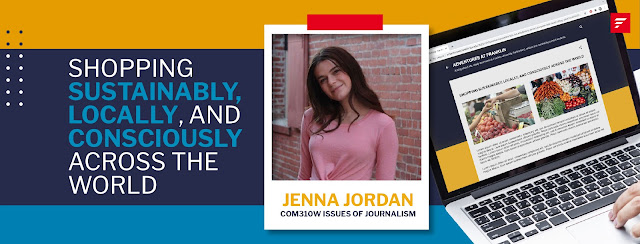Shopping sustainably, locally, and consciously across the world --- by Jenna Jordan '23
It's 8 AM on Tuesday morning and the sun is rising over Napa, California in the United States. The ice on the vines is defrosting, the birds are beginning to chirp, and the locals are heading to do their grocery shopping. About nine hours prior, and 6,000 miles away, in Lugano, Switzerland, these locals had already done the same. However, the commonality of this morning routine is not in the rising sun or the necessary grocery-run, but in how and where this shopping takes place. These Tuesday morning grocery markets are made up of local farmers, butchers, and bakers. The colors of red, pink, and vibrant green help in differentiating the fruits and the veggies, demanding for consumption.
There is no question these sensations are not from the industrial supermarkets in these cities, but this is the description of a farmers’ market. However, a descriptive illustration cannot do these markets justice. Though Napa and Lugano differ in geographic location, they are similar statistically. Farmers markets around the world, including in Napa and Lugano, build community, have loyal customers, and promote sustainable practices, all maintained through the COVID-19 pandemic.
There is a sense of relief and gratification knowing where and how your food was grown. This is rooted in the common phrase “farm-to-table”, which is the promotion of the source of food directly from the growers to the consumers.
The community of people living in both Lugano and Napa value the importance of togetherness. Most recent statistics, according to a Google data source, states that the population of the lakeside Swiss city as of 2017 was 63,932. Comparatively, this population lacks around 15,000 from Napa’s 79,246 as of 2019. However, these numbers seemingly have changed since the recent pandemic.
“You will have many more social interactions compared to a supermarket”. Highlighted in the Napa Farmers Market mission, there is never a lack of interaction or connection between the customer and the seller. Access to farmers markets is not globally available but shopping at larger supermarkets both in Switzerland and California have become a mundane experience, extracting what could be the joy of connections and shopping.
Lugano-based 20-year old university student Peyton Chipman is a frequent market shopper in both the United States and Switzerland. “They'll tell me what is in season right now”. Says Chipman. “And every time I go they give me extra vegetables for whatever is in season.” The charismatic vendors at the markets in Lugano, are one example of the strong sense of community at the market.
When discussing with a local farmers market shopper from Napa, she explained how the market strives to advocate local environmental and social injustices. She quoted the website by saying “the Napa Farmers Market is on a mission to fight food insecurity by increasing access to local fruits and vegetables by our low-income neighbors”. Napa and Lugano markets take grocery shopping to a higher level because farmers markets are inherently sustainable by simply selling what they do.
According to the Food and Agriculture Organization of the United Nations, the percentage of mass production of meats and primary crops has risen over 50%, in addition to a 30% increase in pesticide usage. From simply a one-dimensional perspective that consumers have of the vendors' stands, it is clear that these meats, fruits, or vegetables are not being produced harmfully towards the farmers, consumers, or the environment.
In a capitalist society based on the digitalization of our world, it is necessary to have a business and technological perspective when thinking about the future of these farmers markets. A farmers market is a business within itself, organizing the logistics of the market's functions. The Napa market staff is successful in the continual promotion of the market. A key aspect to a successful business is in relenvency online and offline. The Napa market has tools that are proven to increase awareness of the market as well as education on its importance. These tools are the website, Twitter, Facebook, and Instagram. Comparatively the Lugano market may be popular to some, but raises the question of relevance online.
Filippo, a bread seller at the Lugano Farmers Market, raised an interesting point by saying, “I don’t see many young guys and girls at the market. I see other ages, 40, 50, 60 years old. We are not taught to take our time to go to the market and have a consumer's experience”. He continued to explain that as the “younger” generation, we have the power to begin to incorporate the markets into the fast-paced and economically driven world that we live in. The conclusion that can be made about the future of markets in California, Switzerland, and the rest of the world is education and awareness. At the end of her interview, Chipman summed up her thoughts for the future of farmers markets. “There is definitely a growing awareness of just knowing where your produce comes from and trying to support local businesses, but I am hopeful that more people would be informed.” Chipman finished by saying “And it is easy of course to find information online of where they are happening”.
The younger generation, generation z, now has the power and the tools to seek out more information and build awareness of the local community in their area. Having an understanding of the importance of farmers markets goes beyond eating healthy because it is “trendy”, but because it is sustainable and supportive.
See figure 1.1 for information on the comparison of Lugano and Napa Markets
Sources used:
Pop of napa: https://datacommons.org/place/geoId/0650258?utm_medium=explore&mprop=count&popt=Person&hl=en
Pop of lugano: https://datacommons.org/place/wikidataId/Q7024?utm_medium=explore&mprop=count&popt=Person&hl=en
Napa: https://napafarmersmarket.org/
Stats: http://www.fao.org/3/cb1329en/online/cb1329en.html#chapter-1
***************
This article is part of an assortment of student-written journalistic pieces from Fall ‘21 semester’s “Issues of Journalism” course with Professor Elettra Fiumi.
Learn more on this exciting project here.





Comments
Post a Comment